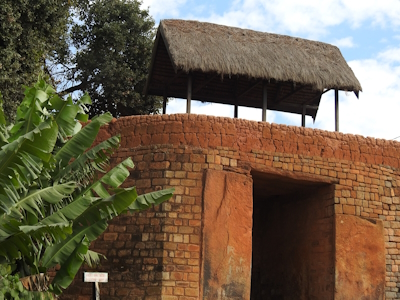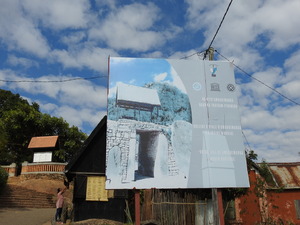Ambohimanga

The Royal Hill of Ambohimanga is an archeological site that contains a ruined city, burial sites, and various sacred places.
Ambohimanga dates from the 16th century and developed into the capital city in the 18th century. The walled city, with stone gates, three palaces, cemeteries and holy places, combines Malagasy and European architectural styles. The hill is also covered with sacred groves, a sacred lake and agricultural terraces. It is still a place of pilgrimage for the local population for the worship of kings and ancestors.
Community Perspective: The site is an easy half-day trip from the capital and is "beautifully set in green countryside looking over a rice paddy filled plain reaching back to Tana". The standard visit includes a guided tour of the royal compound, but it is possible to do a separate 2-hour tour of the sacred forest as well.
Map of Ambohimanga
Community Reviews
Els Slots

The Royal Hill of Ambohimanga is a fortified hill with great historical and symbolic value for the people of Madagascar. It is a wonderful site to visit as it is in good condition and has so many layers: the first unified Malagasy kingdom, the start of its interaction with the outside world just before colonial times, and a contemporary place of worship. I spent 3 hours there on a guided tour of the palace complex and a forest walk.
Although it lies only 20km away from the Madagascar capital Antananarivo, it will take the best part of an hour to get there by car. Leaving the busy city center is the hardest, after that, a fine drive along the rice paddies follows. Ambohimanga is one of many hills in this area. From viewpoints, you can also see the tomb of the King’s astrologer on the adjacent, slightly higher hill. Also, there are the remains of a palace in between these two hills. The astrologer’s hill is a popular place for local worship, the only way to get there is to walk up.
We started the visit to Ambohimanga after entering via the Royal Gate. Local nobility started using this hilltop from the 15th century on, but most of what you now see dates from the early 19th century. The Malagasy royals were a promiscuous bunch, the guide told stories about the Queen that had all her lovers killed or the Prime Minister that ended up marrying three of the queens (the King had 12). The oldest remaining structure is the King’s palace, a traditional Malagasy wooden building, only somewhat larger than the regular houses but with interesting features inside. At the back, the tombs of the ancestors of the first King have been restored and what was left of the human remains has been re-interred, after they had been taken away to Antananarivo by the French in 1897.
The Queen’s palace next door, dating from 1871, has clear European influences. By that time the Malagasy were more aware of the outside world and got connected to foreign royalty. Gifts from Belgium, Spain and the British Queen Victoria have been preserved.
Although the colonial damage done here was brutal (the French wanted to break the Malagasy spirit), it has not destroyed the essence of the site and the residents are clearly proud of it. The slab of stone where the royal zebu were slaughtered is still in place, and yearly offerings continue as can be seen by the newish zebu horns in the collection nailed to the sacred fig tree.
The 2-hour forest walk requires an additional entrance fee and a different guide, and it is not always on offer at the site reception. It did provide a deepening of my understanding of the site overall, so I would recommend taking it. The woodland lies within the larger gated enclosure of the Royal Hill and its large variety of plants and trees was maintained for practical and spiritual reasons. It is almost like a botanical garden and parts of it have been there for hundreds of years. Some plants are for medicinal use, others provide leaves for brewing tea, and strong wood species such as the Madagascar rosewood were used for the construction of buildings. Locals may still use the leaves and fruits, but not cut the trees.
The dense forest also served as an extra layer of defense and along the trails you'll encounter old gates and the remains of a deep moat. There was a gate for the common people, which was the main access road before the French made the current one via the royal gate. And there was a gate that was only used for carrying up deceased people. All gates have a large stone disc that could be rolled into place to close it. The gates were guarded by armed soldiers and also had hedges on top of the walls.
Finally, I’d like to recommend the little café with a panoramic terrace right at the site’s parking lot. Here they do a fine ‘Porc au Ravitoto’, which has a sauce made of crushed and cooked cassava leaves that tastes a bit like spicy spinach. The taboo on eating pork at the Royal Hill – reinstalled after the devastating cyclone of 2012 - seems not to be stringently adhered to!
Read more from Els Slots here.
Thomas Buechler
a visit to the royal palace compound of Ambohimanga will give you a perfect introduction to the Malagasy history and its an easy half day excursion from the capital.The first impression are the huge fig trees at the ceremonial courtyard.this is still a sacred place for Malagasy people and
rituals take place on a daily basis.During the reign of the kings, mainly brown checkered Zebu cows were brought to the royal stables as offerings..nowadays its more on chicken, I was told. Once inside the royal compound, you will be shown the wooden house of the great king Andrianampoinimerina who.. reigned from 1787 to 1810.His majesty used to sleep much higher up than his 12 wifes who had to share one bed on those special days that they all came together to the royal palace from the neighbouring 12 hills. I was also told by the guide that High land people used to be much smaller at that time as there was more Asian than African influence.Therefore the 12 queens could share one single bed!Next to the kings house stands the summer house of the queens, Ranavalona I. reigned long 33 years and she was using this place as a retreat from Antananarivo where the capital has been moved to.With her was her French lover and architect Jean Laborde who was about the only foreign national admired by the queen, until 1847 when also Laborde was expelled because of his involvement in a plot to replace the queen with her son.Behind the burial place for the royals, you can find the small pool where the queen accompanied by 70 virgins used to take her bath.It was a great honour to come and work at the royal palace of Ambohimanga, even just as an ordinary slave.Not to miss the excellent view from behind the palace with Tana in the distance and the white mausoleum of the kings whichdoctor on an adjacent hill.
Solivagant

If you are in Madagascar your prime objective is probably to see Lemur and the other unique ecological aspects of the country. The culture is interesting too having developed from the first immigrants – coming, not from Africa, but some 1500 years ago from the area of present day Indonesia and Malaysia. Meeting the people and seeing their way of life and rituals/ritual objects is also a major plus point for the country.
Ambohimanga, the main “historic site”, is only 20 kms from the capital and should NOT be missed whilst you are there. By the time the British and French vied for control over Madagsacar in the 19th century Madagascar was ruled by a royal line of the Merina clan who came from the highland area around Antananarivo. Ambohimanga was their Palace and later, as Antananarivo became the capital, it in developed as the weekend retreat for the royal family.
The place has a peaceful atmosphere made more poignant by the history of what happened to the royal family who used it. In 1890 the British eventually gave way to the French in return for a free hand in Zanzibar and the French invaded Madagsacar in 1895 eventually deposing the Queen and exiling her to Algeria. The family was never allowed to return by the French.
The compound is beautifully set in green countryside looking over a rice paddy filled plain reaching back to Tana. The wooden buildings include a bedroom and meeting rooms plainly furnished with goods which include gifts from Queen Victoria. Outside there are pens for the royal Zebu. Pilgrims come to pray using the good offices of the spirits of the Queens.
All in all a magical place!
Community Rating
Site Info
- Full Name
- Royal Hill of Ambohimanga
- Unesco ID
- 950
- Country
- Madagascar
- Inscribed
- 2001
- Type
- Cultural
- Criteria
-
3 4 6
- Categories
- Cultural Landscape - Associative Structure - Palace
- Link
- By ID
Site History
2001 Inscribed
Site Links
Unesco Website
In the News
Connections
The site has 19 connections
Constructions
Damaged
Ecology
History
Human Activity
Religion and Belief
Timeline
Trivia
Visiting conditions
WHS on Other Lists
Visitors
64 Community Members have visited.
